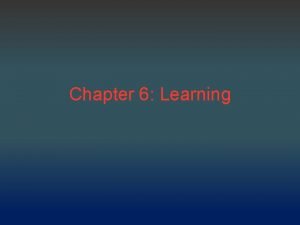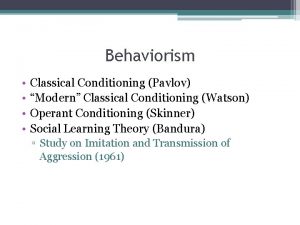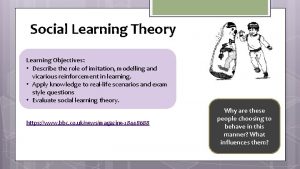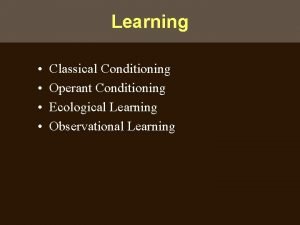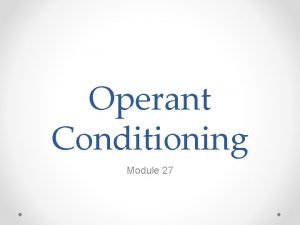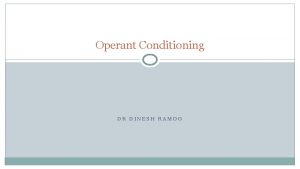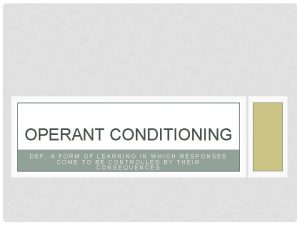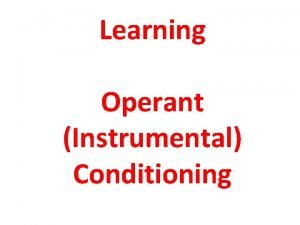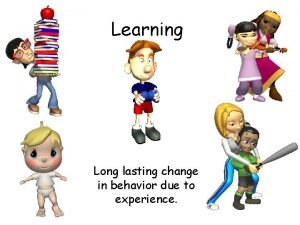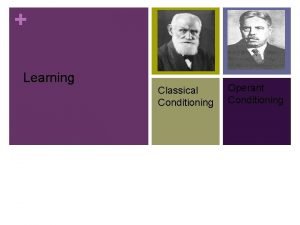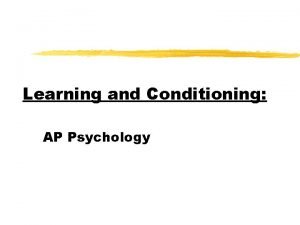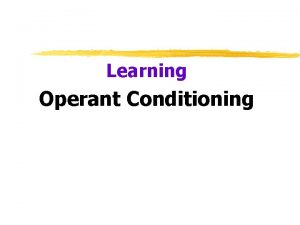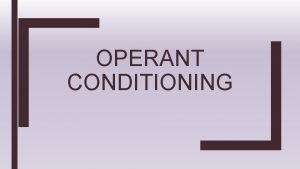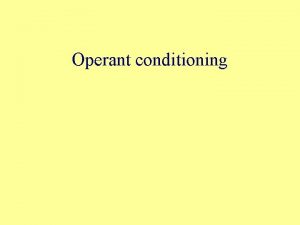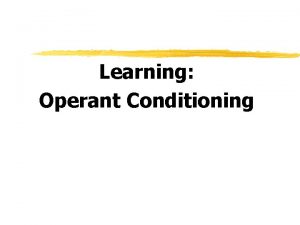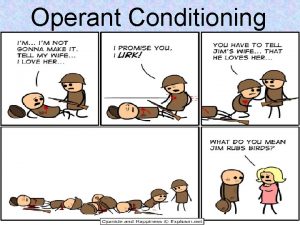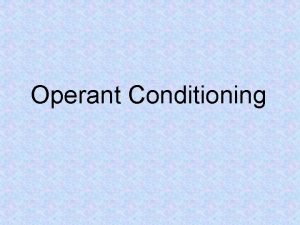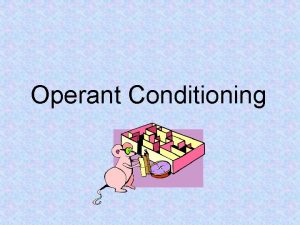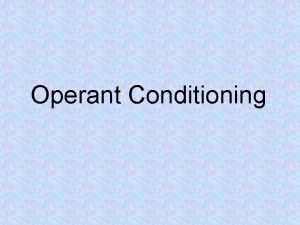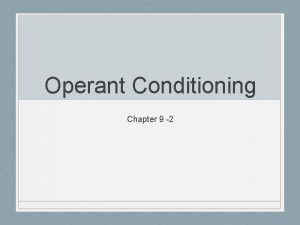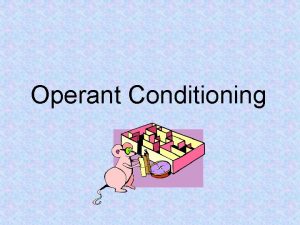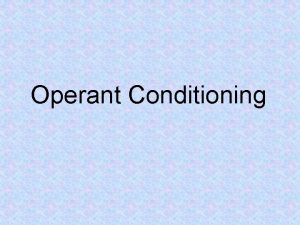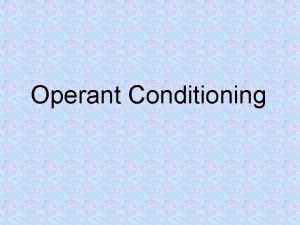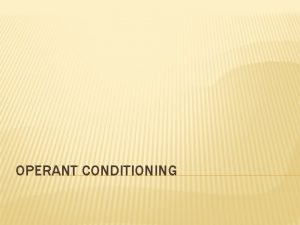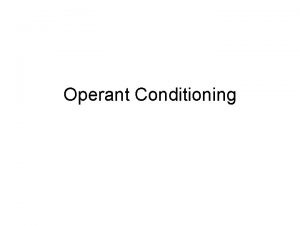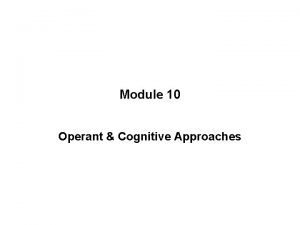Operant Conditioning The Learner is NOT passive Learning























- Slides: 23

Operant Conditioning The Learner is NOT passive. Learning based on consequence!!!


Skinner Box

The Law of Effect Click picture to see a better explanation of the Law of Effect. • Edward Thorndike • Locked cats in a cage • states that "responses that produce a satisfying effect in a particular situation become more likely to occur again in that situation, and responses that produce a discomforting effect become less likely to occur again in that situation. " • Behavior changes because of its consequences. • Rewards strengthen behavior. • If consequences are unpleasant, the Stimulus. Reward connection will weaken. • Called the whole process instrumental learning.

Thorndike’s Puzzle Box

• A reinforcer is anything that INCREASES a behavior. Positive Reinforcement: • The addition of something pleasant. Negative Reinforcement: • The removal of something unpleasant. • Two types of NR • Escape Learning: A type of learning in which the subject acquires a response that terminates some aversive stimulation. • Avoidance Learning: A type of learning in which the subject acquires a response that enables it to avoid an unpleasant stimulus altogether. Determine type of learning: Getting kicked out of class versus cutting class Reinforces

Primary & Secondary Reinforcers

Primary Reinforcement • • Something that is naturally satisfying Examples: food, warmth, water, etc. The item is reinforcing in and of itself If on a deserted island, these are what you’d want!


Conditioned/Secondary Reinforcement • Something that a person has Learned to value or finds rewarding because it is paired or associated with a primary reinforcer • Money is a good example. • So are grades and signs of respect & approval.


Positive or Negative? Putting your seatbelt on. Faking sick to avoid AP Psych class. Studying for a test. Having a headache and taking an aspirin. Breaking out of jail. Getting a kiss for doing the dishes.

Positive/Negative Reinforcement BOTH ARE GOOD THINGS!!!

Reinforcement Schedules How often to you give the reinforcer? • Every time or just sometimes you see the behavior.

Ratio Schedules Fixed Ratio Variable Ratio • Provides a reinforcement after a SET number of responses. • Provides a reinforcement after a RANDOM number of responses. • Very hard to get acquisition but also very resistant to extinction. Fixed Ratio- She gets a manicure for every 5 pounds she loses.

Interval Schedules Fixed Interval • Requires a SET amount of time to elapse before giving the reinforcement. Variable Interval • Requires a RANDOM amount of time to elapse before giving the reinforcement. • Very hard to get acquisition but also very resistant to extinction. Fixed Interval: She gets a manicure for every 7 days she stays on her diet.

Continuous v. Partial Reinforcement • • Continuous Reinforce the behavior EVERYTIME the behavior is exhibited. Usually done when the subject is first learning to make the association. Acquisition comes really fast. But so does extinction. Partial • Reinforce the behavior only SOME of the times it is exhibited. • Acquisition comes more slowly. • But is more resistant to extinction. • FOUR types of Partial Reinforcement schedules.

Premack Principle Emma Key’s might be a great positive reinforcer for me, but it would not work well on a vegetarian. • states that high probability behaviors can be used to reinforce low probability behaviors. • You have to take into consideration the reinforcers used. • Is the reinforcer wanted…. or at least is it more preferable than the targeted behavior.

Punishment Meant to decrease a behavior. Positive Punishment – Addition of something unpleasant. Negative Punishment (Omission Training) – Removal of something pleasant. Punishment works best when it is immediately done after behavior and if it is harsh!

Positive Punishment (Punishment by Application) • Something is added to the environment you do NOT like. • A verbal reprimand or something painful like a spanking

Negative Punishment (Punishment by Removal) • Something is taken away that you DO LIKE. • Lose a privilege.


Token Economy • Every time a desired behavior is performed, a token is given. • They can trade tokens in for a variety of prizes (reinforcers) • Used in homes, prisons, mental institutions and schools.
 Skinner's schedules of reinforcement
Skinner's schedules of reinforcement John watson's little albert experiment
John watson's little albert experiment Deborah skinner
Deborah skinner Instrumental learning vs classical conditioning
Instrumental learning vs classical conditioning Operant conditioning
Operant conditioning Apparent conditioning
Apparent conditioning Secondary reinforcers
Secondary reinforcers Difference between operant and classical conditioning
Difference between operant and classical conditioning Classical conditioning vs operant conditioning
Classical conditioning vs operant conditioning Operant conditioning classical conditioning
Operant conditioning classical conditioning What is social learning theory
What is social learning theory Social learning theory vs operant conditioning
Social learning theory vs operant conditioning Observational learning classical and operant conditioning
Observational learning classical and operant conditioning Difference between lazy and eager learning
Difference between lazy and eager learning Home youtube
Home youtube Puzzle box thorndike
Puzzle box thorndike Premark principle
Premark principle Operant conditioning def
Operant conditioning def Insight learning theory
Insight learning theory Fixed ratio schedule psychology definition
Fixed ratio schedule psychology definition Operant conditioning
Operant conditioning Shaping in operant conditioning
Shaping in operant conditioning Operant conditioning definition
Operant conditioning definition Ap psychology learning
Ap psychology learning







